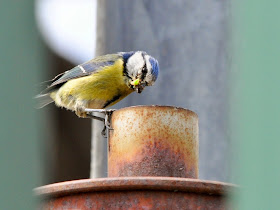In the morning I had checked a Song Thrush nest in a tight hawthorn hedge which meant there was no easy way in or out for my arm. It contained small young so a repeat visit will be required in a few days time assuming they don't get predated. A search for a Willow Tits nest proved fruitless, not that they nest in hawthorns, brambles or nettles, but to access suitable dead wood I had to battle my way through some nettles and thorny thickets.
The best was saved for last when I checked out a new ringing site late in the afternoon. This site is a small overgrown field in a prime agricultural area and belongs to a relative. I was mainly checking it out as a winter feeding site for finches and buntings but quickly noticed the potential for breeding birds. There were 4 pairs of Whitethroats for starters but I was soon absorbed by a pair of Yellowhammers which were carrying food. They were clearly not used to seeing anyone in the field so I had to squat down in the vegetation and watch them from a good 75 metres away before they would ignore my presence.
I watched them carrying food back to the potential nest site for around an hour before I managed to narrow down the location. At first I thought they may be feeding recently fledged young as I could here some begging calls of young birds in the vicinity but my patience paid off and I eventually pinpointed the area they were visiting and marked it as being near a dead S shaped stem.
 |
| Yellowhammer nest location. There or thereabouts from about 10 metres away. |
That was the easy bit, while I knew what my marker looked like through binoculars from 75 metres away the hard part was walking towards the location without losing sight of it. A stem which looks a distinctive S shape from a distance looks anything but a few metres closer and from a slightly different angle, especially when it is amongst hundreds of other dead stems. My first attempt to walk to it failed so I had to go back and wait for the birds to go in again and select a new marker. Both birds dropped into the same spot and this time I marked the location with different stems that I hoped to be able to keep better track of when I approached.
When I went in the second time I was able to keep sight of these markers and found the nest straight away. It was well concealed under some bramble trailers and amongst some willow herb. The nest contained 3 young that were about 7 or 8 days old and the ideal age for ringing.
 |
| Yellowhammer nest containing 3 young, The nest was quite a substantial structure made from coarse grass, other dead stems and lined with horse hair. |
 |
| Yellowhammer nestling. The parents were mainly bringing green caterpillars to feed the hungry chicks. One of the nestlings was slightly smaller than the other two so the parents may have been struggling to find enough food for all three. Unfortunately the weed free fields and reduced headlands of modern agriculture provide much less in the way of caterpillars and other insect food for many of our once common farmland birds. |
 |
| Yellowhammer nestlings about to be returned to the nest. The rings have been blackened with a marker pen so they don't stand out in the nest and get noticed by the parent birds. |
After ringing the nestlings I made sure the nest was as concealed as when I found it and I also carefully covered my tracks as I walked away. I will return in about a week and just watch from a distance to check on progress. The young should be ready to fledge by then or may have just started to wander a little way from the nest as Buntings often leave before they can fly.
Hopefully I will suffer quite a bit of 'nesters arm' over the coming weeks now that the breeding season is getting into full swing.











































